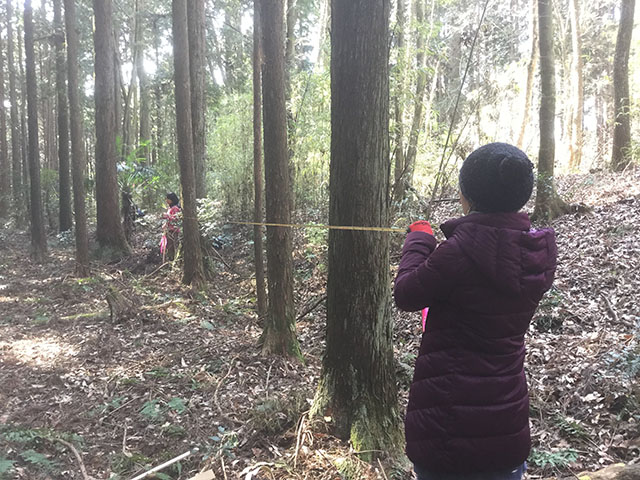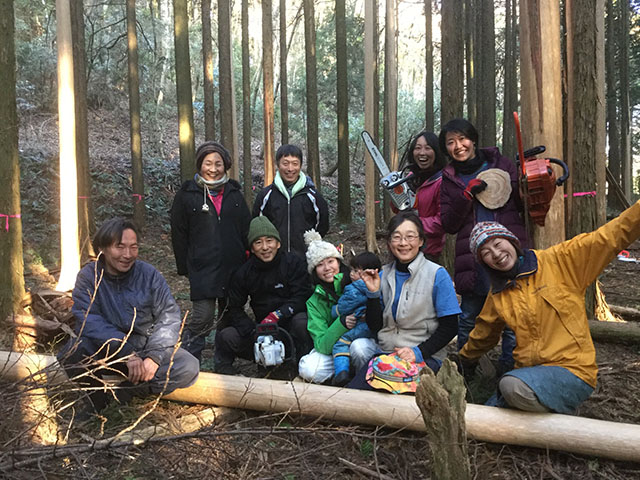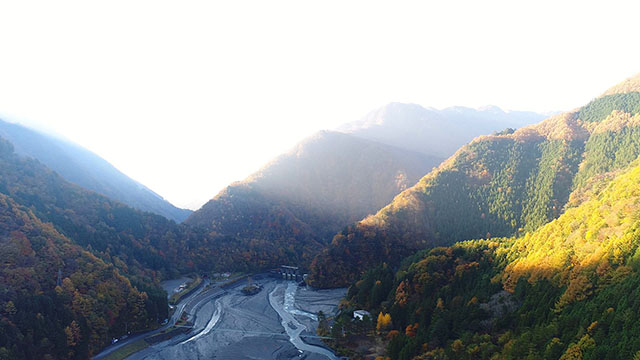|
2018,03,01, Thursday
During our morning walk, neighbor-grandma told me "look at that part of the mountain, those trees are dark green throughout the year. In Narada, we used to call it Kuroki (black trees), and it used to represent the wealth of its land owner." .....And what about today?
 I was not aware of the fact that nearly 80% of Japan's land is covered by forests, but self consumption is less than 30%. After the War, the forest business-managing concept that the trees more useful for materials such as Japanese cedar or Japanese cypress should be planted instead of other small trees began to take hold, so Japanese people were encouraged to plant those trees only. However, Japan started importing cheaper wood since the '60s. I was also not aware that Japan has peen pressing forward the cutting of primeval forests of "South" countries (of the world, geographically and economically) and is now one of the three major wood-importing-countries of the world - at the cost of sustainable lives of local people. Then, what about the forests of Japanese cedar and cypress trees now? They are presently too crowded to grow freely because no one uses these as lumber anymore, so that the sky is covered by a canopy of leaves shielding the forest from sunlight. Therefore, if you walk through the forest, it's so dark, and mostly families of ferns dominate the ground. Now, those mountains are more like a headache to land owners not only because they will go in the red if they place an order to a professional forestry authority for thinning, but also it may cause a landslide afterwards. Moreover, wild animals could come down to the human habitats, seeking food for survival. Furthermore, since imported wood does not suit the Japanese climate and insects, a lot of chemicals are used for preservation, some of which are very harmful to the human body. I was shocked when I saw the presentation conducted by members of Kirameki, an NGO that recommends a unique lumbering technique and usage of trees within the domestic market. At first, Yuki got to know about their activities and joined its network. When he shared the information with me, it was natural that I participated in their study programs and workshops. What's all about this unique lumbering technique? It is peeling the bark off a living tree by hands, drying them slowly (as slow as one whole year!), so that the peeled trees become light enough to cut down and carry easily (even by women!). Surprisingly, the quality of naturally-dried wood are the best in terms of strength and positive effects on human bodies. The alternative thinning, Karameki, recommends is not fighting against the dominating giant economy and negative chains of consumptions, but stepping away calmly and happily from it, to start a sustainable way of using natural resources. They advocate keeping natural resources for the future generations as gifts instead of producing negative souvenirs... Listening to and reading about what they say, I remembered what Umeo or Sukla used to say when they were much smaller. When we were passing by a forest, s/he said "I'm scared of this forest because the trees look like burdocks!" It was a dark and congested forest of Japanese cedars. At that time, I didn't have nothing to say, but now I know that what s/he felt was the core concept. Kirameki groups have established the techniques, and logics to convince and relieve landowners from calculating health check of trees and forests, zoning, selecting trees to cut/keep, safety postures like using chainsaws, carrying logs, pressing lumbered woods, creating jobs and even marketing the products... Actually, I had joined a two-day course of workshops, held in Shizuoka, last weekend to learn the overall concept and processes of Kirameki. It was interesting that Umeo came along because she sensed something attractive. Now coming back from it, the scenery around our settlement got a totally changed outlook. During our morning walk, In the near future, those Kuroki-forests should become representatives of future-wealth once again, I thought. Not only looking up at the mountain, we would like to go further into it this year. Our study has just started! Wakana  森を見上げる いつもの朝のお散歩道、一緒に歩いていたおばあちゃんが私に言いました。「山のあの部分を見てごらん。あそこら辺の木は年中、黒々していてねぇ。ここらでは、昔はクロキなんて呼んで、山主が大黒さん(お金持ちの意)だっていう証だったんだけどねぇ。」・・・それで、今は? 私は、日本の国土の約8割もが森林に覆われていて、なのにその自給率が3割に満たないことなんて、知りませんでした。戦後、雑木の利用から杉や檜といった用材を植林して山林経営を図るといった考え方に移行して、人々は杉や檜の植林を一生懸命植林してきました。けれど、60年代頃から木材は安価な輸入材にとって替わられていき、今でも、日本は『南』の国々の原生林を、そこに先祖代々暮らす人々の持続可能な生活の場である社会保障を伐採し、世界で第三の巨大な木材輸入国であることすら、私は全く知りませんでした。 人々が総出で植えた杉や檜の現在の姿といえば、間伐の手が入らずに過密化が進み、自由に根や枝を伸ばすことが叶わずにいる暗い森として静かにたたずんでいるというのです。木の上部にだけある葉が林を覆い、日の光が木々の間や根本まで届くことを阻んでいる、と。こうした森は、山主さんの頭痛の種となっているそうなのです。伐採あるいは間伐しようと業者さんを呼べば赤字確実なだけでなく、地滑りや食べ物が山で得られなくなった動物たちが里まで下りてくるという獣害にもつながりかねません。 さらに、輸入材は日本の気候や虫たちとも合っていないため、防腐・防虫のために様々な化学物質を用いる必要に迫られるというのです。そこには、日本の法律では野放しのネオニコチノイドなんかも含まれているというのだから・・・。 「(NPO法人)森の蘇り」が提唱する、ユニークな間伐とその木材の国内での利用についての話しを聞いたとき、ガーンと衝撃を受けました。元はと言えば、(ゆ)が彼らの活動を知ってそのネットワークに飛び込み、我が家でその話題が増えるにつけ、自然に私も勉強会に参加するようになったのでした。 そのユニークな間伐とは、一体なんぞ、ということなのですが、私の理解しているところでいうと、生きている木の皮をむくことで一年かけてゆっくり枯らし、乾いて軽くなった木だからこそ、女の人であってもチェーンソーで伐採し運び出すことができる、というもの。そうした天然乾燥された木材は、強度の面でも人体への良影響という面でも最高なのだそうです。この皮むき間伐は「きらめ樹」と命名されていて、この活動を通して、巨大な経済や負の消費のの循環と戦う代わりに、静かにそして喜んで離れていくこと、そして資源を持続可能な方法で活用していくことを呼び掛けています。未来の世代に負のお土産を残すのはもう十分、贈り物を残さなければ、と、こういう話なのです。  「きらめ樹」の話を聞いていた時、ふと、(う)だか(す)が小さいときに言っていたことを思い出していました。どこかの森の横を通り過ぎていた時に、「この森は怖いから好きじゃないなー だってゴボウみたいなんだもん。」その時は、ふーん、と聞き過ごしていたのですが、今となって思えば、鋭いところを突いていたのですね。 「きらめ樹」は中心メンバーと全国の仲間たちが、すでに技術や概念を確立させてきています。それは、山主さんへの説明、木や森の健康診断の方法、区画作りと選木の計算や基準作り、機材を誰もが安全に使用するための体勢指導、伐採された木の運び出しから製材・加工。それら一連の仕事と雇用を作り出すことと市場に出す方法、などなど。。。聞けば聞くほど目からウロコです。  実はこの週末、静岡で開催された、二日間の「きらめ樹」講座に参加していました。活動の概念と間伐から製材の流れを一通り学ぶワークショップです。何かビビッとくるものがあったのか、(う)が一緒についてきて、ご機嫌に過ごしていました。そして、早川町に戻って集落の周りの山を見渡せば・・・見える景色はガラリと変わってしまいます。いつもの朝のお散歩をしながら、考えていました。「クロキ」の森が、もう一度、未来の豊かさの象徴となるようでなければ、だよなぁ。山を見上げるだけではなくて、今年はもっと中に入る機会が増えますように。まだまだ、勉強は始まったばかり。 (わ) 
| カテゴリ: どれみ |
|
